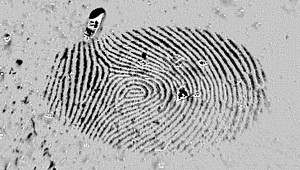
The vacuum metal deposition is divided into several process steps. At first, the exhibit is put into a high-vacuum cabin. There, gold particles are evaporated onto the exhibit. These particles stick to the exhibit only, but not at all to the fingerprint: The skin fat of the fingerprint prevents the particles from sticking to the surface.
Secondly, zinc is evaporated onto the exhibit. Zinc only sticks to the gold particles and intensifies the developed picture. The result is a negative of the fingerprints which is preserved as photography.
The procedure can be applied to plain, fat-free and non -porous surfaces (i.e. fine textiles, lather, glass, plastic, etc.). With older traces, the vacuum metal deposition usually provides with better results than the Cyanacrylate method.
The method is quite expensive in acquisition (vacuum cabin) as well as in operating it.
The vacuum metal deposition was applied in Great Britain for the first time in 1976. Since 1991 it is also used in Germany.
The latent prints which are detected applying the vacuum metal deposition can be digitalized in high quality with EVISCAN and directly transferred into an already existing database, i.e. made available for an AFIS-upload.



